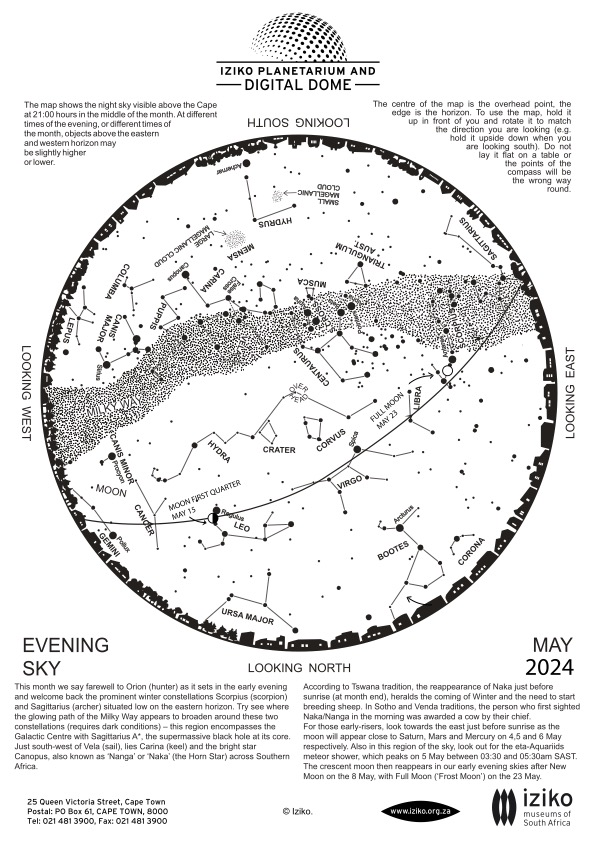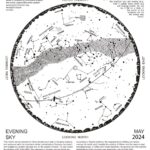
03 May Whats Up – May 2024
In a nutshell…
Moon
| Date | Time | Phase |
|---|---|---|
| 01/05 | 13h27 | Last Quarter |
| 08/05 | 05h21 | New Moon |
| 15/05 | 13h48 | First Quarter |
| 23/05 | 15h53 | Full Moon |
| 30/05 | 19h12 | Last Quarter |
Moon – Earth Relations
Perigee: 363 163 km on 06/05 at 00h04
Apogee: 404 640 km on 17/05 at 20h58
Planet Visibility
Mercury is visible near the stars of the constellation Pisces at the beginning of the month and near the stars of the constellation of Taurus at the end of the month in the morning sky
Venus is not visible this month
Mars is visible near the stars of the constellation Pisces in the morning sky
Jupiter is not visible this month
Saturn is visible near the stars of the constellation Aquarius in the morning sky
Some easy to identify bright stars
Rigel: blue supergiant in Orion
Betelgeuse: red supergiant in Orion
Procyon: yellowish white star in Canis Minor
Sirius: brightest star in the night sky, located in Canis Major
Antares: red supergiant in Scorpius
Arcturus: red giant in Boötes
Spica: brightest bluish-white star in Virgo
Canopus: yellowish-white star in Carina
Altair: a white star, brightest in Aquila
Regulus: blue–white star and the brightest star in Leo
The Pointers: Alpha and Beta Centauri
Sun and Moon
The Last Quarter Moon falls on the 1st of May at 13h27 and the New Moon occurs on the 8th of May at 05h21. The First Quarter falls on the 15th of May at 13h48 and the Full Moon occurs on the 23rd of May at 15h53. Another Last Quarter falls on the 30th of May at 19h12.
On the 6th of May at 00h04, the Moon will be at perigee (closest approach to Earth) at a distance of about 363 163 km. The Moon will be at apogee (furthest from the Earth) at a distance of about 404 640 km on the 17th of May at 20h58.
Planetary and Other Events – Morning and Evening
Mercury, Mars and Saturn can still be observed in the early morning skies before sunrise. The three planets will be lying in a row from the beginning of this month and will be slightly at acute angles towards the end of the month. Both Mercury and Mars are located near the stars of the constellation Pisces at the beginning of the month, but Mercury will have moved near the stars of the constellation Taurus by month-end. Saturn is near the stars of the constellation Aquarius. The Moon will be near Saturn on the 4th of May. Mars will be near the Moon on the 5th of May. The Moon will be near Mercury on the 6th of May.
The asteroid Pallas will be at opposition on the 18th of May and will be best positioned for observation. It will be located near the stars of the constellation Hercules and will be visible between 23h18 and 03h51.
Comet 12P Pons Brook can be observed with the aid of binoculars or a telescope in the West just after sunset. It is expected to be visible till the 11th of May.
The eta-Aquariids meteor shower meteor shower is visible in May. It is active from the 19th of April to the 28th of May, peaking on the 5th of May. About 50 meteors per hour are expected at the peak, and the observing prospects are favourable. The eta-Aquariids meteor shower originates from dust grains ejected by Halley’s Comet. The grains are distributed along the comet’s orbit. Every time the Earth passes through the dust stream, we experience the eta Aquariids meteor shower. To view the eta-Aquariids, look towards the constellation Aquarius between 03h30 and 05h30.
The Evening Sky Stars
Orion can still be seen low in the WNW in the early evening, with bright Sirius (‘The Dog Star’) faithfully following at his heels (or possibly chasing Lepus the Hare into the western twilight). Leo’s upside-down question mark should be easy to spot in the north, above the few stars in the Great Bear that creep above our horizon. A bit higher in the north is lonely Alphard, the brightest star in the Water Snake, while another and much brighter orange star, Arcturus, rises in the northeast. Arcturus’ atypical motion and chemical composition mark it as a likely ‘immigrant’, a star from a smaller galaxy which long ago was “eaten” by our own Milky Way giant spiral. A bit higher in the sky is blue-white Spica, rising in the ENE in early evening. Spica appears to the naked eye as a single fairly bright star, but it is actually a system of 5 stars 260 light years away. The two brightest stars in the Spica system rotate around each other once every 4 days, and are respectively 13 400 and 1700 times as bright as our own Sun.
Paradoxically, most of the stars you can see without a telescope are brighter than our Sun, even though most stars in our neighbourhood are much dimmer than the Sun. This is because we can see bright stars even when they are far away, while most stars would be too dim to spot even at the distance of our closest stellar neighbours. Gliese 581, host star to two very interesting planets, is a typical example. This first of these two planets is about 5-6 times the Earth’s mass and is located in the “habitable zone”, where it is possible for liquid water oceans to exist on the planet’s surface. The second planet is even smaller with a mass about twice that of Earth, but it is closer to its parent star than the former. At only 20 light years away, Gliese 581 is one of our near neighbours, but it is 66 times too faint to see with the unaided eye.
Rising in the southeast are the stars of the Scorpion and the Wolf, with the stars of the Cross and the Pointers high in the SE. Look out for Antares, the bright red star in Scorpius. Well up in the SSW is Canopus, second brightest star in the night sky and brightest in the great ship Argo, serenely sailing along the Milky Way, which runs from Scorpio in the SE to the Twins and the Unicorn in the NW. Accompanying the Argo are the Flying Fish and the Swordfish, with the Fly and the Bird of Paradise flying on ahead.
The Morning Sky Stars
Achernar, the “Little Horn”, shines brightly high in the SE before dawn, with the celestial river Eridanus flowing down toward the east. Assortments of birds occupy much of the southern sky, including (from west to east) the Bird of Paradise, the Peacock, the Crane, the Toucan and the Phoenix. The stars of the Pointers and the Cross are now low in the SW, with the Scorpion, the Wolf and the Altar in the WSW and Sagittarius the Archer still halfway up in the west. The centre of our galaxy, with the most brilliant parts of the Milky Way, is well into the west before dawn, but the Great Rift (a dark band running through the northern Milky Way) is still easy to see. The brightest stars in the NW are Altair in the Eagle, Vega, very low in the NW in the Lyre, and Deneb, the tail of the Swan. The Swan, at the far northern end of our Milky Way on May mornings before dawn, is also known as the Northern Cross. The dim star at the southern end of the Northern Cross is Albireo, a beautiful gold-and-blue double star through a telescope. Albireo’s two suns are far brighter than ours, but they would still be dim compared to Deneb. We don’t know the exact distance to Deneb, and can’t be sure just how bright it is, but the minimum estimate is 60 000 times the brightness of the Sun!
Just east of the point overhead is Fomalhaut, brightest star in the Southern Fish, with the dimmer stars of the Sea Goat and the Water Carrier just to the north. Low in the northeast are the stars of the Great Square of Pegasus, with the two fishes to the south and east, tied together by their tails. Rising in the E before dawn are the stars of the Whale.
But the most carefully watched star on May mornings in at least some parts of Southern Africa was Canopus, known to some as ‘Naka’ (the Horn). Sotho men would camp in the mountains, where they made fires and watched the early morning skies in the South. It was believed that the first person to see the star would be very prosperous that year, with a rich harvest and good luck to the end of his life. In olden times the chief would give the lucky man a heifer. The day after Naka was sighted was the time for the men with divining bones to examine their bones in still water, to predict the tribe’s luck for the coming year. Among the Venda, the first person to see Nanga (Canopus) in the morning sky announced their discovery by climbing a hill and blowing a sable antelope horn (phalaphala). Among the Mapeli, the first person to see the star would begin ululating loudly enough to be heard in the next village, which would then join the noise-making to warn other villages, each in turn until all knew Canopus had been seen. For the Xhosa speaking people, the sighting of Canopus, called uCanzibe, signaled the beginning of the season for the celebration of the last days of boyhood by boys intending to go to the initiation school to become men.
Sivuyile Manxoyi
sivuyile@saao.ac.za
X: @rassivuyile
The evening sky over Cape Town
The evening sky over Johannesburg

